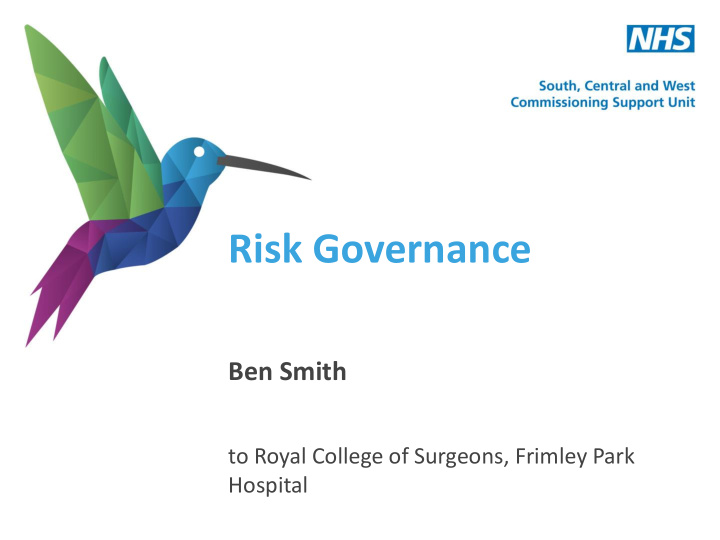



Risk Governance Ben Smith to Royal College of Surgeons, Frimley Park Hospital
Risk • Risks go hand in hand with Opportunities. The challenge: • to enable societies to benefit from change while minimising the negative consequences of the associated risks. ‘Risk Society’ - Innovations in science, technology and communication have caused societies to experience both an increase in knowledge and a greater awareness of a lack of knowledge.
Governance
Risk Governance • Applies to the totality of: actors, rules, conventions, processes and mechanisms… • how relevant risk information is collected, analysed and communicated, • how management decisions are taken.
Risk Governance – A Framework Getting a Risk broad picture assessment of the risk PLUS Concern assessment Is the risk tolerable, acceptable or unacceptable? Is the risk simple, complex, uncertain IRGC Risk Governance Framework, 2008 or ambiguous?
Pre-Appraisal Establish a broad picture of the risk and how to assess and manage it ► What are the risks and opportunities we are addressing? ► What are the various dimensions (causes, targets, scope, scale, etc) of the risk? How do we define the limits for our evaluations and decisions? ► Do we have indications that there is already a problem? Is there a need to act now…at all? ► Who are the stakeholders? How do their views affect the definition and framing of the problem ? ► What are the scientific/analytical tools and conventions that can be used to assess the risks? ► What are the current legal/regulatory systems and how do they potentially affect the problem and how it is handled? ► What is the organisational capability of the relevant governments, international organisations, businesses and people involved? Introducing the IRGC’s Risk Governance Framework 13 | 64
Risk Communication Policy makers need: • knowledge about the physical impacts of technologies, natural events or human activities • but also knowledge about the concerns that people associate with these and other causes of risks. Needing trust in decision makers, people must: 1.accept (adapt to…) 2.manage (reduce, regulate, build resilience…) and/or 3.transfer (insurance) the risk they experience or perceive.
Risk Communication – potential gaps • Alienating the ‘irrational’ concerns • One way e.g. “If they receive the information…” • Low Level of trust
Risk Governance Communications How to:
Risk Communication at Different Stages (1) PREASSESSMENT • Internal • Informing other agencies and getting feedback from them (who is affected and how does it relate to their mandate?) • External • Media briefing about process to start • Inviting stakeholders to provide feedback and framing suggestions (if risk appears to load high on uncertainty and ambiguity)
Risk Communication at Different Stages (2) APPRAISAL • Internal • Informing the appropriate scientific departments in other agencies and, if necessary, organize workshops • External • Media briefing and announcement to stakeholders that assessment process is on its way ( low complexity ) • Depending on degree of knowledge, press conferences or press releases on results ( high complexity ) • Conducting hearings, Delphi, or other information gathering techniques with appropriate knowledge carriers ( high complexity and uncertainty )
Risk Communication at Different Stages (3) EVALUATION • Internal • Involving all affected agencies if risk characterisation is either uncertain or evaluation controversial • External • Press conferences with assessors and managers on evaluation results and protective measures ( low uncertainty and ambiguity ) • Information of stakeholders and invitation for written review ( high uncertainty and low ambiguity ) • Deliberation with stakeholders about values/perspectives and assigning trade-offs ( high ambiguity )
Risk Governance Conclusions • Good risk governance integrates traditional risk analysis with the thorough understanding of how different stakeholders perceive the risk (“framing” and “concern assessment”) • Understanding and acting on how different stakeholders frame the risk is a key factor in the overall success of the process • Categorising the knowledge about the risk as simple, complex, uncertain or ambiguous can help: • select a risk management strategy • design the process for stakeholder involvement • Using the results of both risk assessment and concern assessment can support a tolerability/acceptability judgement that accounts for both scientific facts and people’s perceptions
Risk Governance (NHS background)
Risk Governance Challenges (NHS) • Feasibility of managing blame culture within - blame avoidance can create strong incentives for manipulation of risk assessments • Make little reference to ‘uncertainty’ element within best practice guidance. • Subjective and Objective elements selective? • Administrative burden or shaping decisions?
Risk Governance example • Colleges and regulators coming together • Consider cultural challenges (reporting) • Elements of precautionary principle (Class III)
Recommend
More recommend